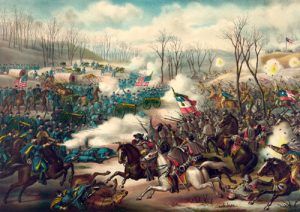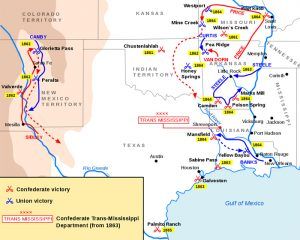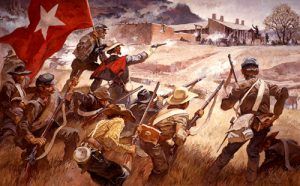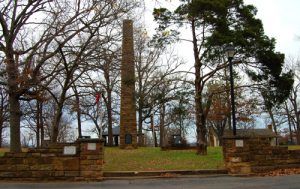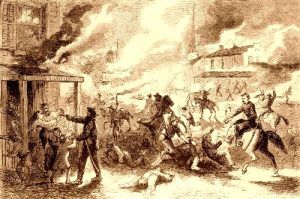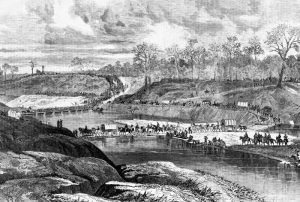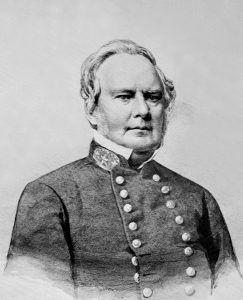Trans-Mississippi Theater of the Civil War – Legends of America (original) (raw)
Battle of Pea Ridge, Arkansas, by Kurz & Allison.
The Trans-Mississippi Theater Campaign of the Civil War was the major military and naval operation west of the Mississippi River, with the exception of those near the Pacific Coast. The Confederate Trans-Mississippi Department was formed on May 26, 1862, after recognizing problems associated with trying to govern a region more than a thousand miles distant from the capital at Richmond, Virginia. The area included Missouri, Arkansas, Texas, Indian Territory (Oklahoma), and Louisiana west of the Mississippi River.
Until the surrender of Vicksburg, Mississippi, the Trans-Mississippi region offered many important resources, including significant numbers of men, Texas cattle, war goods from Mexico, and Texas and Louisiana cotton. Additionally, the small Army of the Trans-Mississippi the Union to keep a military presence in the region, thus tying up men who could have been used elsewhere.
After the summer of 1863, Arkansas, Louisiana, and Texas no longer made a significant contribution to the Confederacy. As a result, the states along the east bank of the Mississippi River suffered too. Tennessee, with its capital under Union control, could offer little to the Confederate war effort but men. Even within the Army of Tennessee, Trans-Mississippi Confederates from Texas occasionally deserted to go home to protect family and friends from marauding Indians. By ignoring the needs of the western Confederacy, and allowing the isolation of the Trans-Mississippi, Confederate President Jefferson Davis forced leaders in the region to rely on their own resources and manpower. Both politicians and military commanders knew that by 1864 the region’s inhabitants had become less willing to send their soldiers elsewhere and that many soldiers would refuse to go. It is true that Trans-Mississippians failed to provide the needed diversions for the fighting in late 1864 and as a result A. J. Smith helped destroy John B. Hood’s army at the Battle of Nashville, but the failure of Confederate leaders to see the Trans-Mississippi as an asset in 1861, or even as a source of manpower to protect the Mississippi River Valley in Arkansas and Louisiana early in the war, ranks as one of the major failures of Confederate strategic thinking. It can also be argued that the manpower to cover all the states from the Carolinas to Texas was simply not there, and when Davis set his priorities, he decided to sacrifice the Trans-Mississippi in order to use the soldiers to defend important cities in the Western Theater.
Trans-Mississippi Theater of the Civil War
Yet this decision fostered resentment and frustration among Confederates west of the river. Once Vicksburg, Mississippi fell and the Trans-Mississippi became a semi-independent department, the region’s leaders, both civilian and military, made no concentrated attempt to aid the overall war effort and essentially ignored Jefferson Davis’s plea of “one cause, one country” fighting together “for the defense of each other.” As a result, the Union ultimately proved more successful at combining its resources on both sides of the river, while the Confederacy maintained two distinct areas of operations west of the Appalachian Mountains—uncoordinated and separated—to the end.
Operations to Control Missouri, June-October 1861
Boonville, Missouri – June 17, 1861
Carthage, Missouri – July 5, 1861
Wilson’s Creek, Missouri – August 10, 1861
Dry Wood Creek, Missouri – September 2, 1861
Lexington, Missouri – September 13-20, 1861
Liberty or Blue Mills, Missouri – September 17, 1861
Fredericktown, Missouri – October 21, 1861
Springfield, Missouri – October 25, 1861
Operations in the Indian Territory – November-December 1861
Round Mountain, Oklahoma
Chusto-Talasah, Oklahoma
Chustenahlah, Oklahoma
Operations in Northeast Missouri – December 1861
Mount. Zion Church, Missouri
Roan’s Tan Yard, Missouri
Battle of Glorieta Pass, by Roy Anderson
Sibley’s New Mexico Campaign – February-March 1862
Valverde, New Mexico
Glorieta Pass, New Mexico
Pea Ridge Campaign – March 1862
Operations on the White River – June 1862
Saint Charles, Arkansas
Operations Near Cache River – July 1862
Hill’s Plantation, Arkansas
Missouri Soldier by Enoch Long
Operations North of Boston Mountains – August-November 1862
Clark’s Mill, Missouri
Kirksville, Missouri
Independence, Missouri
Lone Jack, Missouri
Newtonia, Missouri
Old Fort Wayne, Oklahoma
Operations to Suppress the Sioux Uprising – August-September 1862
Fort Ridgely, Minnesota
Wood Lake, Minnesota
Operations to Blockade the Texas Coast – September 1862-January 1863
Sabine Pass, Texas
Galveston, Texas
Prairie Grove Battlefield
Prairie Grove Campaign – November 1862
Cane Hill, Arkansas
Prairie Grove, Arkansas
Operations Against Galveston – December 1862-January 1863
Galveston, Texas
Marmaduke’s First Expedition into Missouri – January 1863
Springfield, Missouri
Hartville, Missouri
Marmaduke’s Second Expedition into Missouri – April-May 1863
Cape Girardeau, Missouri
Chalk Bluff, Arkansas
Operations to Control Indian Territory – June-September 1863
Cabin Creek, Oklahoma
Honey Springs, Arkansas
Devil’s Backbone , Arkansas
The Lawrence, Kansas Raid as illustrated in Harper’s Weekly, September, 1863.
Quantrill’s Raid into Kansas – August 1863
Operations to Blockade the Texas Coast – September 1863
Sabine Pass II, Texas
Advance on Little Rock – September-October 1863
Bayou Fourche, Arkansas
Pine Bluff, Arkansas
Occupation of Indian Territory North of the Arkansas River – October 1863
Baxter Springs, Kansas
Red River Campaign – March-April 1864
Civil War in Louisiana by C.E.H. Bonwill
Fort De Russy, Louisiana
Mansfield, Louisiana
Pleasant Hill, Louisiana
Blair’s Landing, Louisiana
Monett’s Ferry, Louisiana
Mansura, Louisiana
Yellow Bayou, Louisiana
Camden Expedition – April 1864
Elkin’s Ferry, Arkansas
Prairie D’Ane, Arkansas
Poison Spring, Arkansas
Marks’ Mills, Arkansas
Jenkin’s Ferry, Arkansas
Expedition to Lake Village – June 1864
Old River Lake, Arkansas
Sterling “Old Pap” Price
Price’s Missouri Expedition – September-October 1864
Fort Davidson, Missouri
Glasgow, Missouri
Lexington, Missouri
Little Blue River, Missouri
Independence, Missouri
Byram’s Ford, Missouri
Westport, Missouri
Marais des Cygnes, (Kansas)
Marmiton River, Missouri
Mine Creek, Kansas
Newtonia, Missouri
Expedition from Brazos Santiago – May 1865
Palmeto Ranch, Texas
Compiled and edited by Kathy Alexander/Legends of America, updated December 2021.
Also See:
